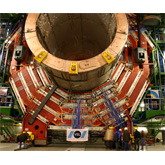The end of physics as we know it?

U physicists are part of a search for new matter and dimensions
By Deane Morrison
September 10, 2008
Like Alice taking the plunge down a rabbit hole, the world's physicists today went underground in search of exotic forms of matter, extra dimensions of space, and an answer to the question of how matter acquires mass. The biggest experiment in physics got its start 100 meters below the French-Swiss border near Geneva, when a mammoth machine called the Large Hadron Collider, or LHC, had its first trial run. The LHC is a project of CERN, the European Organization for Nuclear Research, and it is the fruit of 15 years' labor by more than 1,700 physicists and engineers around the world, including about 25 from the University of Minnesota. The purpose of LHC is to recreate in miniature a hot, energy-charged environment that hasn't existed since a few milliseconds after the Big Bang. This is expected to generate forms of matter never seen before, such as the mysterious "dark matter" that forms the bulk of the matter in the Universe. That aspect of the project has occupied University physics professor Roger Rusack, who has been on the project since its inception. He has helped design and build detectors to study the new states of matter. "This is the experiment to probe where dark matter comes from," he says. "The Universe contains seven times more dark matter than visible matter, and we haven't a clue what that [dark matter] is."
"The stored energy in a beam is equivalent to a train with 100 wagons, each weighing 100 tons, going at 100 miles per hour."
Two other physics professors are also working on the LHC: Yuichi Kubota and Jeremiah Mans, who is currently at CERN to help operate one of the detectors for the LHC's maiden run.
A smashing time
The extremely high-energy conditions in the first microseconds of the Universe's life occurred back before all the building blocks of matter and the fundamental forces that govern their behavior had taken their present forms. The LHC will recreate that state of affairs by sending two beams of protons (particles found in every atomic nucleus), each traveling at nearly the speed of light, on a collision course. When the protons meet, their component parts will collide to make new forms of matter. Physicists hope the release of energy in the collisions will also produce a particle called the Higgs boson, which is believed to be necessary in conferring mass on all other particles. The energy release may even reveal new dimensions of space. If new particles and dimensions can be created, then physicists can study them and refine their theories of how the Universe was created and structured. So, just how much energy will be released? Protons may be tiny, but each beam will pack more wallop than the high-speed trains that carried some LHC physicists to Geneva. "The stored energy in a beam is equivalent to a train with 100 wagons, each weighing 100 tons, going at 100 miles per hour," says Rusack. The beams travel inside a 17-mile circular track, with some of the world's most powerful magnets steering them around. The prodigious amounts of energy released in such collisions have led some people to fear that the LHC will produce mini black holes that could grow and swallow the world or weird particles, appropriately called strangelets, that could also wreak havoc. University physics professor Joseph Kapusta, who has followed the history of such concerns, says that similar fears have been raised when other particle accelerators were built. "I know of no professional physicist who is truly worried that experiments at the LHC could go so disastrously wrong that they would cause the destruction of the Earth," he says. "Let us wish bon voyage for the thousands of scientists going on a journey of exploration of a lifetime." Read an earlier article about the U's involvement in the LHC.
